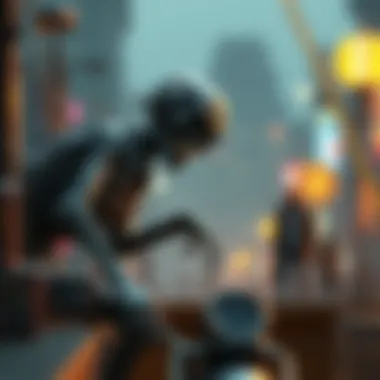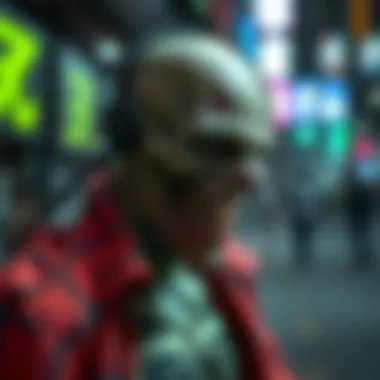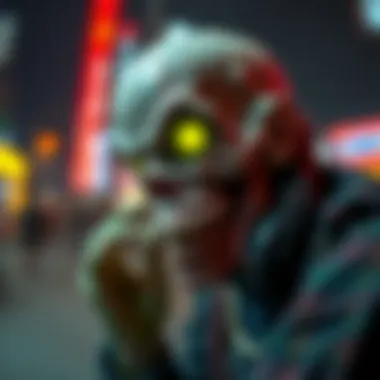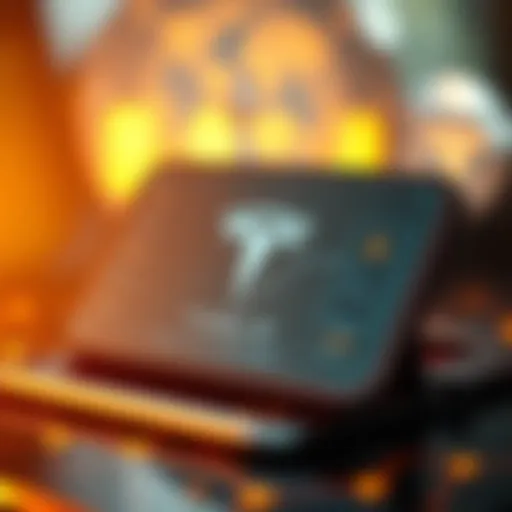Examining Zombie NFTs in the Crypto Realm


Intro
The world of cryptocurrency continues to evolve at a breakneck pace, and within this landscape, Zombie NFTs have emerged as a notable phenomenon. These unique digital assets, often inspired by the macabre and fantastical elements of zombie culture, are garnering attention from collectors, investors, and enthusiasts alike. But what exactly are Zombie NFTs, and why are they gaining traction in the crypto market? This section seeks to outline the complexities of Zombie NFTs, shedding light on their origins, cultural significance, and potential future developments.
Zombie NFTs are a blend of art, culture, and technology, defined as non-fungible tokens that represent ownership of unique digital items often featuring zombie themes. Like their more traditional NFT counterparts, these digital collectibles operate on a blockchain, ensuring authenticity and ownership. However, the draw of Zombie NFTs lies not only in their artistic merit but also in their encapsulation of a broader cultural zeitgeist, where the fascination with the undead intertwines with technological innovation.
In this article, we will first explore the current trends in cryptocurrency, specifically examining how Zombie NFTs fit into the larger tapestry of digital assets. We will then delve into the nitty-gritty of investment strategies tailored to this niche market, offering insights for both seasoned investors and newcomers alike. From the risk factors to consider to the long-term value these unique tokens may hold, this narrative aims to equip readers with a comprehensive understanding of the nuances surrounding Zombie NFTs.
Whether you are a trader, an investor, or simply a tech enthusiast, the aim is to peel back the layers of this fascinating subject, much like a skilled zombie slayer unearthing the secrets of the undead. The ensuing sections will provide a coherent narrative that highlights the impact of these NFTs on the crypto ecosystem and their implications for collectors and investors moving forward.
Prologue to Zombie NFTs
In recent years, the rise of Digital Art and the concept of ownership on the blockchain has given birth to a unique niche within the crypto landscape: Zombie NFTs. These digital collectibles, steeped in both horror and nostalgia, signify not just an artistic movement but also a novel investment frontier. As we dive into the world of Zombie NFTs, it's crucial to grasp what makes this topic significant and its ramifications in the broader context of cryptocurrency and cultural phenomena.
Importance of Zombie NFTs
Zombie NFTs serve as an intersection of art, culture, and technology, making them a fascinating case study for traders, investors, and tech enthusiasts alike. Their importance can be broken down into several key elements:
- Cultural Resonance: Zombies hold a prominent place in popular culture, often representing the fears and anxieties of society. This thematic engagement boosts the appeal of Zombie NFTs among collectors who are not just after monetary gains but also cultural symbols.
- Technological Innovation: Built on blockchain technology, Zombie NFTs showcase the capabilities of decentralized ledgers, particularly in establishing verifiable ownership and provenance in a digital space. This advances understanding of how digital assets can be securely traded and collected.
- Economic Potential: The market for NFTs, particularly themed ones, is burgeoning. Zombie NFTs have shown promising trends in valuation and trade volume that draw serious attention from investors seeking to expand their portfolios into new and unique assets.
- Community Dynamics: The creation and trading of Zombie NFTs foster community engagement. Fans and collectors often come together to participate in events or forums, enhancing the overall culture surrounding these products.
As we dissect what Zombie NFTs encompass, it is essential to note that they represent more than just a gimmick; they encapsulate the melding of artistic expression with the limitless potential of blockchain technology.
Defining NFTs
Non-fungible tokens (NFTs), at their core, are digital representations of ownership, unlike cryptocurrencies such as Bitcoin or Ethereum, which are fungible and can be exchanged on a one-to-one basis. An NFT is unique and cannot be replicated, allowing for the ownership of distinct items, be it digital art, music, or collectibles.
NFTs operate on blockchain technology, typically utilizing the Ethereum network, which provides a secure and transparent framework for transactions. Imagine owning a digital piece; you have not just a copy but verified ownership of an original piece of art, the authenticity of which is recorded on the blockchain. This characteristic adds value, as it is tantamount to having an original painting hanging on your wall instead of a mere print.
Consider the implications:
- Provenance and Scarcity: Just like in physical art markets, the rarity of an NFT can significantly affect its value. Artists can create a limited number of NFTs, giving collectors exclusive pieces.
- Market Accessibility: NFTs democratize access to art and collectibles. Anyone, regardless of their geographical location or socio-economic background, can purchase or trade NFTs.
- Immutability: Ownership records on the blockchain cannot be altered, which safeguards against fraud. This attribute is paramount in establishing trust among collectors.
Overall, defining NFTs clarifies the innovative nature of digital ownership that is fundamental to understanding Zombie NFTs.
The Concept of Zombies in Popular Culture
Zombies are cultural icons, deeply embedded in various forms of media—from films like "Night of the Living Dead" to video games such as "Resident Evil". They symbolize societal fears, often reflecting themes of apocalypse, consumerism, and the uncanny.
The interests surrounding zombies have ebbed and flowed, but their consistent presence in pop culture breeds a mythology of their own that NFT art taps into. This phenomenon allows creators to leverage the powerful imagery and narratives associated with zombies:
- Cultural Critique: Zombie narratives often comment on collective anxieties; they can illustrate themes such as societal collapse or the dilemmatic nature of human existence. Incorporating zombies into NFT art speaks to a shared understanding of these themes.
- Engagement through Nostalgia: For many, zombies evoke a sense of nostalgia. The visual elements and storytelling resonate with audiences who grew up in the era of zombie films and games, encouraging a personal connection to the NFTs these elements inspire.
- Interactivity and Community: The rise of zombie-themed digital assets also fosters a sense of community. Fans often engage in discussions, contribute to fan art, or collaborate on storylines that enhance the universe of Zombie NFTs.
These dimensions illustrate that Zombies are not just monsters; they embody complex ideas that enrich the Zombie NFT landscape. The amalgamation of cultural significance with cutting-edge technology lays a groundwork for understanding the broader implications of this themed digital art.
Historical Context of Zombie NFTs
Understanding the historical context of Zombie NFTs provides vital insights into their significance in the realm of cryptocurrency. Just like any cultural phenomena, the evolution of these unique digital assets is rooted in a blend of technological advancements and the appetite of the market. By dissecting the background of NFTs, as well as the rise of zombie themes in popular culture, one can truly grasp the complexities and appeal of Zombie NFTs in today's crypto landscape.
The Genesis of NFTs
The origin of non-fungible tokens can be traced back to the early days of blockchain technology. Initially, Bitcoin dominated the scene, operating solely as a currency. It was not until 2012 that Ethereum introduced smart contracts, which revolutionized the ownership of digital assets. This pivotal change paved the way for the creation of NFTs - a way to represent unique items on the blockchain.


- Unique Digital Ownership: As opposed to cryptocurrencies like Bitcoin or Ethereum, which are interchangeable, NFTs provide proof of ownership for distinct assets.
- Art and Collectibles: The rise of digital art in 2017, especially with applications like CryptoKitties, showcased the potential of NFTs and garnered attention from artists and collectors alike.
- Gems in a Sea of Tokens: The emergence of platforms like OpenSea, Rarible, and Foundation further facilitated the trade of NFTs, making them accessible to the masses.
To summarize, the development of NFTs hinged upon technological innovation and market enthusiasm, setting the stage for the intersection of Zombie culture and the digital asset realm.
Emergence of Zombie Themes
The idea of zombies is ingrained in modern culture, evolving from folklore to a staple in film and videogames. The fascination with undead characters stems not only from their gory allure but also from the philosophical questions they provoke about society and humanity.
- Movies and Games: Films like "Night of the Living Dead" set the groundwork in the 1960s, while titles such as "Resident Evil" and "The Walking Dead" have solidified the zombie narrative in contemporary media.
- Cultural Commentary: Zombies often symbolize societal concerns, from consumerism to isolation in urban settings. This provides fertile ground for thematic exploration within digital art and NFTs.
As digital art surged in popularity, creators began to experiment with combining their unique styles with these familiar figures. Zombies started appearing in various forms as NFTs, allowing enthusiasts to not just enjoy the art but also participate in an evolving community.
"The art of the undead weaves itself into the tapestry of modern digital expression, engaging collectors in a narrative as old as time itself."
The Mechanics Behind Zombie NFTs
When discussing Zombie NFTs, it’s essential to understand the mechanics that make them tick. This section delves into the technical underpinnings, bringing clarity to how these digital assets are created, bought, and sold within the broader cryptocurrency landscape. Understanding these mechanics isn't just about grasping technology; it’s about recognizing the potential and challenges that lie ahead for creators and investors alike.
Blockchain Technology Fundamentals
Blockchain technology serves as the backbone of all NFTs, including their zombie-themed counterparts. At its core, blockchain is a distributed ledger that ensures transparency and immutability. Each transaction that takes place is recorded in a block, chained to the previous one, thus creating an unchangeable record.
The fundamentals of blockchain are pivotal in the context of Zombie NFTs because:
- Decentralization: Unlike traditional systems governed by central authorities, blockchain operates on a peer-to-peer network. This means that no single entity controls the entire chain, which fosters a sense of trust among users.
- Smart Contracts: These self-executing contracts with the terms of the agreement directly written into code mark a significant advancement. They automate transactions, ensuring that Zombie NFTs can be bought or sold without the need for intermediaries, streamlining the experience.
- Ownership Verification: Each NFT is unique and tied to a specific wallet address on the blockchain, making ownership clear and verifiable. This is crucial when dealing with valued assets that collectors wish to purchase or exchange based on their rarity or artistic merit.
In sum, the blockchain is the digital backbone that empowers the existence and authenticity of Zombie NFTs, establishing a framework for their exchange and trade.
Creating Zombie NFTs: A Technical Overview
The creation of a Zombie NFT involves a series of deliberate steps that blend creativity with technical knowledge. Here’s a snapshot of the process:
- Conceptualization: It all starts with an idea. The creator must have a vision of the zombie-themed asset they wish to develop, whether it's a piece of artwork, an animated character, or a game asset.
- Design and Development: Using graphic design software, artists craft their NFTs. Tools like Adobe Illustrator or Blender are popular choices. This phase focuses on the aesthetic appeal, which is crucial given that zombie culture often leans heavily on visual impact.
- Minting: Once the design is ready, it needs to be minted. This is where the NFT is created on the blockchain. The minting process involves using specific platforms like Ethereum or Binance Smart Chain, which often have their protocols. A simple code snippet typically resembles:contract MyZombieNFT is ERC721 // your code here
- Listing and Marketing: After minting, the NFT is listed on marketplaces such as OpenSea or Rarible. The marketing angle can’t be overlooked; creators often engage on social media platforms to garner interest.
- Sale and Transfer: Once buyers show interest, the NFTs can be sold. Blockchain takes care of the transaction, transferring ownership seamlessly through smart contracts, ensuring a smooth transition from seller to buyer.
"Creating Zombie NFTs isn't merely about code; it's the fusion of imagination with advanced technology."
Through these mechanisms, Zombie NFTs come to life, tapping into the cultural zeitgeist while providing a rich ground for investment opportunities. Understanding these underlying mechanics helps potential creators and investors navigate the complexities of this intriguing market.
Economic Aspects of Zombie NFTs
The emergence of Zombie NFTs brings forward an intriguing intersection of cultural phenomena and economic dynamics within the vast crypto landscape. As these digital assets make their mark, it’s important to dissect how they’re valued and their implications for creators, collectors, and investors alike. Understanding the economic aspects of Zombie NFTs can unveil insights into trends that not only shape individual portfolios but also impact broader market movements.
Market Trends and Valuation
Market trends related to Zombie NFTs are evolving quicker than a horde of fast zombies in a blockbuster flick. Evaluating the valuation of these assets requires a keen eye on several factors:
- Rarity and Uniqueness: The scarcity of a Zombie NFT can drive up its value. Limited editions or unique designs that break the mold often fetch higher prices. The allure lies not just in ownership but also in uniqueness.
- Celebrity Endorsements: Just like a famous movie, when a notable figure jumps onto the Zombie NFT bandwagon, the marketplace buzzes with excitement. The backing of recognizable names tends to elevate NFT prices significantly.
- Cultural Resonance: Practically speaking, if the Zombie NFT taps into current cultural trends—like new zombie-themed games or movies—its value can skyrocket as it resonates with fans and collectors.
- Market Liquidity: The ease of buying and selling Zombie NFTs plays a crucial role in their valuation. Marketplaces with higher liquidity allow for quicker sales, driving demand and pricing up.
- Community Engagement: The strength and involvement of the community surrounding a specific Zombie NFT can affect its market value. Communities that build around collectibles often incentivize buying behavior through shared enthusiasm and collaboration.
In essence, the value of a Zombie NFT is less about its inherent properties and more about the factors that surround it.
Furthermore, keeping one’s finger on the pulse of market trends can provide valuable predictive insights. Analyzing data from platforms like OpenSea or Rarible could deliver key indicators of upcoming shifts.


Investment Perspectives on Zombie NFTs
Investing in Zombie NFTs is akin to navigating a labyrinth; opportunities are present, but so are pitfalls that investors need to watch out for. Here are some perspectives to keep in mind:
- Risk vs. Reward: Entering into Zombie NFT investments can lead to significant rewards for those who time their entries well. However, due to the speculative nature of NFTs, the risks are equally high. Investors should weigh potential payouts against the likelihood of market corrections.
- Diversification: Just as you wouldn’t put all your eggs in one basket, diversifying investments across various types of NFTs, including Zombies, can mitigate risks. Investing in different themes or creators can buffer against the volatility of any single asset.
- Long-term Horizon: For collectors, thinking long-term could pay off. Zombie NFTs may not always yield immediate returns, but as the crypto ecosystem evolves and if the theme continues to attract attention, their values can rise significantly over time.
- Research: It’s imperative that potential investors do their homework. Understanding the backstory and unique attributes of a specific Zombie NFT, as well as monitoring community discussions on platforms like Reddit or social channels, can inform buying decisions.
- NFT Utility: Some Zombie NFTs might offer added utility, such as access to exclusive events or communities. These added benefits can enhance their value beyond mere digital ownership.
Navigating the world of Zombie NFTs can be a rewarding journey, but it requires diligence and a strong market awareness. The dance between trends, valuation, and community engagement plays a crucial role in determining where this emerging asset class fits into the broader investment landscape.
Cultural Impact of Zombie NFTs
The cultural significance of Zombie NFTs continues to grow, intertwining various aspects of art, entertainment, and community dynamics. As these digital assets evolve, their role transcends mere collectibles, becoming a focal point where technology meets creativity. The cultural impact of Zombie NFTs can be dissected through two main lenses: their representation in art and media, and the ways they foster community engagement.
Zombies in Art and Media
Zombies have long been a staple in popular culture, often depicted in films, television, and literature. Their representation speaks to deeper societal fears and fascination with mortality and the unknown. With the emergence of Zombie NFTs, this portrayal has found a new medium—digital art. Artists channel the horrors and humor of the zombie genre into unique, verifiable pieces of art that resonate with collectors and enthusiasts.
For instance, consider the work of Robert H. Finnegan, a digital artist who melds traditional horror aesthetics with modern digital techniques. His Zombie NFT pieces often explore themes of decay, loss, and the absurdity of human existence. This blend appeals to fans of both horror and digital art, allowing a wider audience to engage with the work. By representing zombies in a new format, artists like Finnegan redefine traditional boundaries, pushing the envelope of what constitutes art in the contemporary landscape.
Moreover, Zombie NFTs allow for interactivity in ways traditional media does not. Collectors become part of the narrative; they can participate in community discussions and exclusive events. This interactive nature fosters a sense of belonging, transcending the conventional relationship between artist and audience. As a result, the cultural footprint of Zombie NFTs expands; they become more than just collectibles, aligning closely with the culture of fandom surrounding the zombie genre.
Influence on Community Engagement
The rise of Zombie NFTs has sparked vibrant communities around them, showcasing the power of digital technology in fostering connections. These online spaces allow fans, artists, and collectors to converge, share ideas, and collaborate. This engagement is not purely transactional; it’s about building connections, forming friendships, and participating in a shared passion.
Consider platforms like Discord, where NFT communities thrive. Here, enthusiasts dedicate channels to discuss not only the art but also the broader implications of zombie culture in relation to societal issues. Topics range from the critique of consumerism in zombie narratives to exploring themes of survival in a digital age. Such dialogues enrich the experience surrounding Zombie NFTs.
Additionally, community-driven events, like virtual galleries or competitions featuring Zombie NFTs, further strengthen these bonds. Participants not only showcase their collections but also engage in friendly debates about their favorite pieces, artists, and the evolution of zombie imagery. This collaborative spirit often spills into social media, where hashtags and project announcements can create ripples of interest and excitement.
“Zombie NFTs are not just digital assets; they represent a community of passionate creators and collectors who share a unique narrative.”
In summary, the cultural impact of Zombie NFTs is significant. It reshapes how we perceive artistry, blurs the lines between creator and consumer, and cultivates engaging communities. As these digital artifacts evolve, so too does their role within broader cultural conversations, challenging and redefining the intersections of art, technology, and social interaction.
Zombie NFTs and Community Dynamics
The world of Zombie NFTs is not just a matter of digital art or collectible assets; it’s about the communities that form around them. This section will unpack the significance of community engagement and collaboration among creators, both essential elements propelling Zombie NFTs forward in the ever-evolving crypto landscape. As these digital zombies roam the blockchain, they carry with them the collective spirit of their creators and collectors, making community dynamics crucial to their success and sustainability.
Collaboration Among Creators
Collaboration is the secret sauce in the Zombie NFT realm. Independent creators have banded together, forming collaborations that amplify their reach and creativity. This interplay isn’t just about pooling resources; it involves sharing ideas and refining concepts to create more innovative and attractive NFTs. For instance, when artists merge their unique styles, the resulting pieces not only reflect diverse influences but also create a richer narrative. Take a look at projects where several artists team up to create themed collections, like a Zombie Movie franchise where each artist illustrates a unique zombie character. These collaborations pique interest and ultimately attract a larger audience.
The mechanics behind these partnerships can vary. Some see it as a simple shared platform, while others establish formal collaborative entities. This means if an artist creates exclusively for a Zombie project, they outgrow their individual practice, merging their efforts with others. Engaging in such dynamics helps expand visibility and brings in fresh interpretations. This unity fosters a sense of belonging within the community, allowing creators to learn from each other’s successes and failures.
Additionally, creators often take to social media platforms like Twitter and Discord to engage in conversations, share their progress, and brainstorm new ideas. These interactions turn mere artistic ventures into a communal experience. Through sharing and collaboration, the community thrives, resulting in more engaging and dynamic Zombie NFT projects.
Fan Engagement Strategies
For any NFT project to bloom, implementing effective fan engagement strategies is essential. Community-driven initiatives play a vital role in building a loyal following. Many Zombie NFT creators involve their fans in the creative process, seeking input on themes, character designs, and even potential storylines. This feedback loop creates not just collectors but dedicated advocates for the project.
Here are a few effective strategies that have been employed:
- Exclusive Access and Rewards: Offering fans early access to new drops or exclusive behind-the-scenes content fosters loyalty. When collectors feel valued, they’re more likely to actively promote the project.
- Interactive Experiences: Online events such as AMAs (Ask Me Anything) sessions or virtual zombie-themed parties enable fans to directly interact with the creators. These experiences deepen connections, allowing fans to relate to the creators on a more personal level.
- User-Generated Content: Encouraging users to create content based on existing Zombie NFTs, such as fan art or stories, turns passive collectors into active participants. Not only does it generate buzz, but it also enriches the community narrative.
- Community Contests: Hosting contests for the best zombie character design or storyline can stir excitement. Winners could earn exclusive NFTs or the chance to be featured in the next collection, which drives participation and creativity.


Ultimately, these strategies cultivate engagement and interaction that are key to sustaining interest and growth within the community. The reciprocal relationship between fans and creators allows Zombie NFTs to thrive in a competitive market, establishing a unique ecosystem driven by passion and creativity.
In the world of Zombie NFTs, community engagement is not merely an ancillary benefit; it is an integral aspect of their success. The collaborative web formed by creators and the loyalty of fans transform these digital assets into something much larger than their individual value, creating a thriving culture around the undead.
Challenges and Controversies in the Zombie NFT Market
Navigating the realm of Zombie NFTs isn’t a stroll in the park. The market is riddled with complexities that can ensnare even the most seasoned traders and collectors. As investors dive into this aesthetic world of digital undead, understanding the challenges and controversies prevalent in the market is paramount. Not only does this knowledge inform better decision-making, but it can also help in avoiding potential pitfalls that may arise in one’s NFT journey.
Intellectual Property Issues
One major concern surrounding Zombie NFTs revolves around intellectual property rights. As creators conjure up these digital ghouls, the question of originality looms large. On one hand, artists pay homage to existing zombie lore; on the other, this homage can inadvertently trample on existing copyrights. For instance, if a Zombie NFT embodies a character or theme closely associated with a film or comic book, the creator might be treading on shaky ground. This arises from multiple avenues:
- Derivative Works: Many NFTs are crafted based on existing culture, but where does homage end and infringement begin? Creators must be mindful of this precarious line.
- Licensing Agreements: It’s crucial that creators secure proper licensing if they aim to utilize established characters or elements, ensuring that their Zombie NFTs don’t face potential legal hurdles.
- Community Norms: The NFT community has its own unwritten rules, with some creators willing to share their work while others might brandish a more possessive attitude towards their creations.
"In the murky waters of the NFT scene, familiarity with intellectual property laws can be a lifesaver."
Market Volatility and Speculation
Another critical aspect to consider is the market volatility surrounding Zombie NFTs. Speculative trading can make this space as unpredictable as a wild goose chase. The sheer hype surrounding the latest Zombie NFT drop often sends prices skyrocketing, but this is frequently followed by sharp declines that leave many holding bags of loss.
- Price Fluctuations: It’s not uncommon to see NFT prices fluctuate wildly within days, making it hard to gauge fair value.
- Short-Term vs. Long-Term Investing: While some seek immediate returns in this passionate ecstasy of undead art, others eye long-term value, which may not always materialize given the current trends.
- FOMO and Hype: Fear of Missing Out often drives impulsive buying decisions. Investors can find themselves caught in a whirlwind of bad choices prompted by emotion rather than careful analysis.
Future Prospects of Zombie NFTs
The landscape of Zombie NFTs carries immense potential that is not merely a fleeting trend; it signifies a broader evolution within the cryptocurrency realm. As technology advances and public interest in digital assets grows, the future of Zombie NFTs will likely be shaped by numerous factors including technological advancements, changing market dynamics, and evolving collector preferences. Understanding these elements is crucial for traders, investors, and tech enthusiasts alike, as it opens doors to opportunities previously unimagined.
Technological Innovations on the Horizon
The fusion of creativity and technology in the NFT space is constantly evolving. Zombie NFTs have the potential to be significantly impacted by emerging innovations. For instance, developments in augmented reality (AR) and virtual reality (VR) could allow collectors to experience their Zombie NFTs in immersive environments. This would elevate the way these digital assets are perceived and interacted with.
- Decentralized Platforms: There’s a growing trend towards using decentralized platforms to mint and trade NFTs. Blockchain networks like Ethereum are continually improving their scalability and transaction speeds. This means that as more users hop onto these platforms, Zombie NFTs can gain broader acceptance.
- Interoperability Between Blockchains: Future innovations could lead to improved interoperability, allowing Zombie NFTs to be traded across different blockchain platforms. This would open new avenues for collectors and investors, enhancing liquidity and market access.
- Smart Contracts with Enhanced Features: As programmers create more sophisticated smart contracts, we may see features like royalties built into the Zombie NFT framework. Creators could thus benefit from ongoing sales, providing them with a sustainable revenue model.
"In the world of NFTs, those who anticipate the next wave of technological change will ride the crest of the digital revolution."
Evolving Collector Preferences
As with any collectible trend, the preferences of collectors play a pivotal role in the traction and longevity of Zombie NFTs. The community around these digital assets is dynamic, reflecting shifts in taste, culture, and technological trends.
- Diversity in Designs: Collectors are continuously seeking unique designs and innovative approaches. The incorporation of gamification elements, where Zombie NFTs unlock special features or experiences within games, could captivate a wider audience.
- Narrative and Aesthetic Value: Future collectors may lean heavily towards Zombie NFTs that offer compelling narratives or distinct artistic styles. This aligns with the growing demand for art that tells a story, combining aesthetics with deeper meanings.
- Sustainability and Ethical Considerations: Recent trends show a shift toward sustainability in art and collectibles. Collectors might prefer platforms that emphasize eco-friendly practices in minting NFTs, influencing their purchasing decisions significantly.
The End: The Future of Zombie NFTs in Crypto
As we look ahead into the future of Zombie NFTs, it's clear that this phenomenon has a pivotal role to play in the larger cryptocurrency arena. These digital assets are not just a passing fad; their unique cultural significance and the technological backbone they rest upon ensure they are here to stay. With their distinctive artistic styles and community-driven initiatives, the relevance of Zombie NFTs is likely to multiply, drawing in a wider audience and transforming how we perceive collectibles.
Integrating into the Broader Crypto Ecosystem
The integration of Zombie NFTs into the broader crypto ecosystem signifies an evolving landscape where art, technology, and community mesh seamlessly. As more creators and collectors join the fray, we are bound to see an uptick in collaboration among different platforms. For instance, these NFTs can serve as a bridge connecting various decentralized applications, which can enhance interactivity and user engagement.
In practical terms, one can envision scenarios where art from popular Zombie NFT collections could be used in gaming environments, or even integrated into virtual and augmented reality spaces. This not only elevates the appeal but also opens doors for innovative monetization strategies, making them versatile assets in the crypto marketplace.
Final Thoughts on Collectibility and Investment
When it comes to contemplation on collectibility and investment, Zombie NFTs stand as both a novel investment opportunity and a matter requiring caution. The market, while ripe for swift gains, presents volatility that potential investors must navigate carefully. Here lies an opportunity: the uniqueness and cultural embeddedness of Zombie NFTs can make them compelling collectible items, especially for those aligned with gaming and pop culture.
However, it's crucial to appraise the value of these tokens beyond mere speculation. Scrutinizing artwork, understanding the community behind each NFT, and recognizing the technological nuances can greatly assist in making informed decisions. Collectors should also maintain a keen eye on the legal landscape, as ownership and intellectual properties in the NFT world continue to evolve.
As in any investment, education plays a key role. Continued engagement with enthusiasts, understanding market dynamics, and aligning oneself with reputable projects can mitigate risks and enhance the overall experience of collecting Zombie NFTs.
In summary, as we advance into this intriguing phase of cryptocurrency, Zombie NFTs will undoubtedly carve out a significant niche, intertwining technology with artistic expression and community camaraderie.





